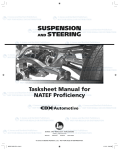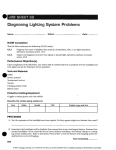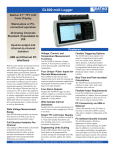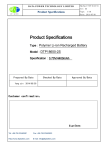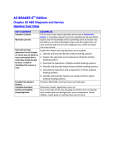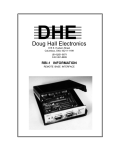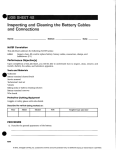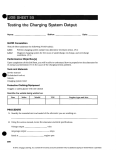Download Electrical/Electronic Systems with solutions
Transcript
electricalsystem-solutions.doc, p. 1 Name: ___________________________________ Date: _______________ Electrical/Electronic Systems Work Example 1 WorkKey Level: 4 NATEF Automotive Task: VI.D.1 The specs for this alternator reads…puts out 90% of output. The alternator reads 112 amps and has a rated output of 135 amps. a. Is this within specs? b. What would the acceptable performance limit have to be in order for this to be an acceptable reading? c. What would the alternator have to produce to be within 90% of the rated output? Solution a. No b. The acceptable performance limit would have to be approximately 82.9%. (112 amps/135 amps = 0.8296296296...) c. The alternator would have to produce 121.5 amps. (135 amps)(90%) = (135 amps)(0.90) = 121.5 amps Electrical/Electronic Systems Work Example 2 WorkKey Level: 3 NATEF Automotive Tasks: VI.B.1 While testing a battery under no load, the battery has 12 1/4 volts. What is the approximate state of charge percentage according to the chart below? Open circuit volts 11.7 volts or less Percentage of charge OR State of charge 0% 12.0 volts 25% 12.2 volts 50% 12.4 volts 75% 12.6 volts or more 100% electricalsystem-solutions.doc, p. 2 Solution 12 1/4 = 12.25, which is approximately 12.2 Reading from the chart, the percentage of charge is approximately 50%. Electrical/Electronic Systems Work Example 3 WorkKey Level: 4 NATEF Automotive Tasks: VI.B.2 During a battery capacity test, 50% of the cold cranking amperage should be pulled for 15 seconds. On a battery with a rating of 700 cold cranking amps, how many amps should be drawn from the battery for the test? Solution (700)(50%) = (700)(0.50) = 350 amps Electrical/Electronic Systems Work Example 4 WorkKey Level: 3 NATEF Automotive Tasks: VI.A Look at the voltmeter below. The spec sheet says that the voltage drop must be less than 0.3 volt. Which of the following readings is (are) acceptable? 400mv 300mv 200mv 100mv None are acceptable. electricalsystem-solutions.doc, p. 3 Solution Since the voltage drop must be < 0.3 volts, there are two acceptable readings: 200mv and 100mv. Electrical/Electronic Systems Work Example 5 WorkKey Level: 3 NATEF Automotive Tasks: VI.A Which of the following readings is (are) acceptable if the spec sheet states that the voltage drop must be less than 0.5 volts? 0.500v 0.050v 0.005v 5.000mv none Solution Since the voltage drop must be < 0.5 volts, there are three acceptable readings: 0.050v, 0.005v, and 5.000mv. Electrical/Electronic Systems Work Example 6 WorkKey Level: 4 NATEF Automotive Tasks: VI.A You are checking voltage at a switch. There are 12.2 volts at Terminal A and 11.4 volts at Terminal B. What is the voltage drop? Solution The voltage drop is (12.2 – 11.4) = 0.8 volts. electricalsystem-solutions.doc, p. 4 Electrical/Electronic Systems Work Example 7 WorkKey Level: 6 NATEF Automotive Tasks: VI.A.12, VI.A.14, VI.H.7 The customer wants to know if he can attach his power booster to his radio circuit. His power booster uses 200 watts; can he attach it to the radio circuit? Use Ohm’s law to show him if he can or cannot do this. Use the drawing and chart to show the customer where he can hook up his power booster. (The battery voltage is 12.6.) V = I × R = Ohm’s law + Component Amp Key On Radio 6 Key On Cig lighter 10 Key On Windows 15 Always Aux Open Solution First, you must decide how many amps the power booster needs. 200 = 12x x = 200/12 = 16.6 The booster alone will need 16 2/3 amps. Next we need to determine how many open amps each component has. Radio: 10 – 6 = 4 open Cigarette lighter: 20 – 10 = 10 open Windows: 20 – 15 = 5 open Auxiliary: 20 open The only place the customer can attach his power booster is to put it in auxiliary. Electrical/Electronic Systems Work Example 8 WorkKey Level: 4 NATEF Automotive Tasks: VI.A.10, VI.A.12 What is the reading on the ohmmeter shown below? Where would the needle point if the switch was moved to x1000? electricalsystem-solutions.doc, p. 5 Solution By looking at the odometer, the reading is approximately 26. Since the switch is pointed to the x100, you must multiply the reading by 100. (26)(100) = 2600 ohms If the switch was pointed to x1000, then the reading would be (2600/1000) = 2.6 ohms. Electrical/Electronic Systems Work Example 9 WorkKey Level: 4 NATEF Automotive Tasks: VI.B.1 You must determine whether a battery should be replaced. You take a specific gravity reading of each cell. The readings are as follows: Cell Reading 1 1.145 2 1.182 3 1.131 4 1.131 5 1.158 6 1.173 Your service manual states that a battery must be replaced if there is a range of 0.050 (50 points) in the specific gravity readings of the cell. a. What is the lowest specific gravity reading of the cells? b. What is the highest specific gravity reading of the cells? c. What is the range of the specific gravity readings of the cells? d. Should you replace the battery? electricalsystem-solutions.doc, p. 6 e. How can you explain the need for a new battery to a customer? Solution a. Reading from the chart, cells 3 and 4 have the lowest reading of 1.131. b. Reading from the chart, cell 2 has the highest reading of 1.182. c. The range of specific gravity readings is 0.051. (highest – lowest) = (1.182 – 1.131) = 0.051 d. Yes e. Answers will vary. Electrical/Electronic Systems Work Example 10 WorkKey Level: 4 NATEF Automotive Tasks: VI.B.1 Open-circuit voltage test (sealed batteries) Your service manual states that the battery must pass the state-of-charge or open-circuit voltage test before a capacity test, which provides a realistic determination for battery replacement. If the battery shows less than 12.2 volts, it should be recharged before the capacity test. If the state of charge is 75% or more, the battery is considered charged. Using a digital multimeter (DMM) set on DC volts, you perform an “Open-circuit voltage test” by checking the voltage across the positive and negative battery terminals. The results of this test can indicate a battery’s state of charge. You measure 11.8 volts at 80°F on the open-circuit voltage test. Open-circuit voltage State of charge at 80°F 12.6 or greater 100% 12.4 to 12.6 volts 70%–100% 12.2 to 12.4 volts 50%–75% 11.7 to 12.0 volts 0%–25% 11.7 or less 0% a. What voltage reading indicates a 100% charge? b. What does your reading indicate? c. What reading indicates a 75% charge? d. Should you recharge or replace the battery? e. How can you explain the need for a new battery to a customer? electricalsystem-solutions.doc, p. 7 Solution a. 12.6 volts or greater (Read from the chart.) b. Our reading of 11.8 volts indicates a 0% to 25% charge. c. 12.4 volts (Read from the chart.) d. Recharge the battery first e. Answers will vary. Electrical/Electronic Systems Work Example 11 WorkKey Level: 5 NATEF Automotive Tasks: When you apply your brake, all three brake lights are dim. The two brake lights each have a resistance of 2 ohms. The center brake light has a resistance of 4 ohms. Your meter reads 4 ohms at the base of the parallel circuit. Is the reading within the circuit’s parameter? Solution Rt = (R1 × R2 × R3)/(R1 + R2 + R3) Rt = (2 × 2 × 4)/(2 + 2 + 4) = 16/8 = 2 Since Rt = 2 and the meter reads 4 ohms, it is not within parameters. R1 = 2 R2 = 2 R3 = 4 R1 × R 2 R1 + R 2 = R EQ × R3 R EQ + R3 2•2 4 = =1 2+2 4 = 1× 4 4 = = 0.8Ω 1+ 4 5 Electrical/Electronic Systems Work Example 12 WorkKey Level: 5 NATEF Automotive Tasks: On a parallel circuit, R1 is 2 ohms and R2 is 4 ohms. Find the total resistance and total current draw on a 12-V battery. electricalsystem-solutions.doc, p. 8 Solution RT = total resistance in a parallel circuit R1 = 2 ohms R2 = 4 ohms RT = (2·• 4)/(2+4) = 8/6 = 4/3 = 1.3 ohms 1/RT = 3/4 (3/4)·(12/1) = 9 amps Electrical/Electronic Systems Work Example 13 WorkKey Level: 4 NATEF Automotive Tasks: The lights are not working in a car and you are testing several electrical components. When you test the wiring for your headlight the amp meter gives a reading of 2.5 amps. The headlight has a resistance of 5 Ω. Is there a problem in the wiring? Solution 12.6 v/5 ohms = 2.52 amps No Electrical/Electronic Systems Work Example 14 WorkKey Level: 4 NATEF Automotive Tasks: Ohm’s law states that E = I*R where E = voltage, I = amperage, and R = resistance. Find the resistance if the voltage is 12 and the amperage is 2. Solution E = I*R 12 = 2(R) 12/2 = R 6=R The resistance is 6 ohms. electricalsystem-solutions.doc, p. 9 Electrical/Electronic Systems Work Example 15 WorkKey Level: 4 NATEF Automotive Tasks: The reading on the ohmmeter is 0.342 and the switch is on 2k ohms. a) What is the reading in ohms? b) What is the reading in milliohms? Solution a) 0.342 ohms × 1000 = 342 Ω b) 342 ohms × 1000 = 342,000 mΩ or 0.34 KΩ Electrical/Electronic Systems Work Example 16 WorkKey Level: 3 NATEF Automotive Tasks: In a series circuit the sum of the resistors equals the total resistance of the circuit. In a circuit, resistor 1 = 3 ohms and resistor 2 = 8 ohms. What is the total resistance of the series circuit? Solution 3 ohms + 8 ohms = 11 ohms total resistance Electrical/Electronic Systems Work Example 17 WorkKey Level: 5 NATEF Automotive Tasks: You are helping a buddy install a light bar on his four-wheel-drive truck, which has a 12-volt battery. It uses four huge spotlights so he can 4 wheel at night. They are hooked up in parallel and use 1-ohm-resistance bulbs. He is continually blowing 30-amp fuses! Does he have a short or is the fuse too small? Oh yeah? Well—prove it! electricalsystem-solutions.doc, p. 10 1. Calculate total circuit resistance using the attached diagram. ___________ 2. Use Ohm’s law to figure the current. __________ 3. Determine the problem. Solution 1. Rt = 0.25Ω 2. 48 A 3. The fuse is too small. Electrical/Electronic Systems Work Example 18 WorkKey Level: 4 NATEF Automotive Tasks: VI.A.8 The voltage drop in an automotive starter relay switch is 0.4 volt. There are 12.7 volts at terminal “D.” What is the voltage at terminal “E”? Solution 12.7 volts – 0.4 volt = 12.3 volts electricalsystem-solutions.doc, p. 11 Electrical/Electronic Systems Work Example 19 WorkKey Level: 6 NATEF Automotive Tasks: A given V8 will have an ideal current draw of 200 amps. The specs allow for a tolerance of ±10%. Starter circuit resistance is 0.03 and battery voltage is 12.6 V. Will the circuit fall within specifications? Solution Ohm’s law: Volts = Amps × Ohms A car has 12.6 volts, and the resistance is 0.03 ohm. Amps = 12.6/0.03 = 420 amps Since 220 amps is the maximum range, the starter circuit is not within range.











